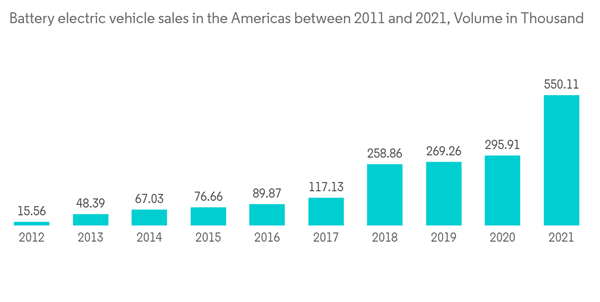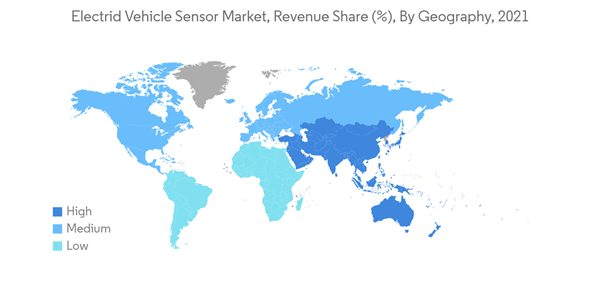The COVID-19 pandemic and associated bottlenecks in the supply chain hampered the electric vehicle manufacturing supply chain during the first half of 2020. However, as the lockdown measures were eased, the demand for electric vehicles started picking up pace. In 2020, electric vehicle sales (battery electric vehicles) witnessed an increase of around 33%, which continued in 2021. Such growth in electric vehicle sales is anticipated to drive the demand for a variety of sensors. These sensors include sensors associated with battery management, driver assistance systems, active and passive safety systems, etc.
Over the long term, the growing use of semi-automated and automated vehicles in transportation and logistics will spur the development of electric vehicle sensors. Many prominent players are integrating various sensors such as radar, image, LiDAR, and infrared to improve road safety and autonomous mobility. Growing concerns about the safety of autonomous vehicles have led governments to accept and adopt them across the world. One of the key factors driving market demand is the increasing use of sensors in autonomous vehicles. The increased use of image sensors, temperature sensors, position sensors, and speed sensors in ADAS/AD systems will boost the market growth as the electric vehicle demand is anticipated to be driven by the development of autonomous and semi-autonomous vehicles.
Due to restraining factors like the high cost of electric vehicles, along with a shortage of semiconductors, the market faces challenges.
In the coming years, the European electric vehicle sensor market is anticipated to grow significantly, attributing to the rising demand for cutting-edge technologies, like IoT and AI, in the automotive sector for electric mobility. To ensure passenger safety, systems like ADAS (Advanced Driver Assistance Systems) and EBD (Electronic Brake Force Distribution) are increasingly incorporated into electric vehicles, which further supports product acceptance. Furthermore, the policy environment still drives the uptake of electric vehicles. The 10 leading countries, such as China, the United States, Norway, Germany, the United Kingdom, France, Sweden, and the Netherlands, in electric vehicle adoption have a range of policies to promote the uptake of electric vehicles.
Governments are implementing initiatives and reforms, with heavy investments in the electric vehicles sector, to boost demand and encourage the adoption of electric vehicles in their countries worldwide. In August 2021, the United Kingdom government promised to invest GBP 20 million in projects that help develop zero-emission heavy goods vehicles (HGVs). The Department for Transport (DfT) estimates that the money may help increase the number of zero-emission HGVs on UK roads and improve the infrastructure for such vehicles.
Electric Vehicle Sensor Market Trends
INCREASE IN PRODUCTION OF SEMI AUTONOMOUS PASSENGER VEHICLES FOSTER THE DEMAND OF ELECTRIC VEHICLE SENSOR MARKET
The demand for autonomous and semi-autonomous vehicle technologies has increased as a result of growing safety and security concerns among consumers. Some potential advantages of autonomous and semi-autonomous vehicles include reduced vehicle accidents, improved fuel efficiency, and increased engine productivity. Price reductions of this magnitude, such as those experienced by LIDAR (whose price dropped from USD 75,000 to USD 7,500), are expected to accelerate market expansion.Segmental growth will be fueled by rising demand for automotive electrification and the incorporation of cutting-edge safety and infotainment systems into vehicles. To ensure that EV batteries are used to their full potential, these systems employ a variety of powertrain sensors, including those that measure temperature, speed, position, current, and ultrasonics.
Additionally, sensors are increasingly used in ADAS and automated driving to provide more critical information about a vehicle's surroundings as improved sensors for connected and autonomous infrastructure becomes available. Smart automobiles and luxury vehicles will also drive demand for automotive sensors. The increasing popularity of electric vehicles is also increasing the demand for sensors. Non-contact 3D magnetic sensors are being encouraged by vehicle manufacturers to replace potentiometers or optical systems that leverage traditional position-sensing techniques. These sensors minimize wear and contamination, reduce space, and provide accurate readings in high-temperature environments. Moreover, pressure sensors are becoming an essential component of engine and safety systems. When the accelerator or brake pedals are depressed, the sensors within the engine monitor the oil and coolant pressures and control the power that the engine produces. This allows the engine to maintain the desired speed.
Furthermore, in terms of safety features, pressure sensors are a crucial component of the anti-lock braking system (ABS). This technology adjusts to the road surface and guarantees that while stopping at high speeds, the tires do not lock, and the car does not slide. The pressure sensors in ABS inform the processor of road conditions and the vehicle's speed. Dubai has stated that by 2030, 10% of all vehicles will be electric or hybrid, and by 2050, the city-state will be the first in the region to be emission-free. In line with this, the government is attempting to electrify its public fleet, with the Dubai RTA focusing on expanding its fleet of electric vehicles.
In February 2021, MG Motors launched the latest model of MG ZS EV in India. The ZS EV was launched in India as the brand’s second model in the market. It was also introduced as the brand’s first all-electric vehicle. The ZS EV is equipped with a 44.5 kWh battery pack, which MG claims is good enough for 350 km of driving range on a single charge.
Such growth in government support, announcements by governing bodies and OEMs to halt manufacturing and sales of fossil fuel-powered vehicles, and availability of cost-friendly electric vehicle models are anticipated to drive the market in focus during the forecast period.
ASIA-PACIFIC REGION IS EXPECTED TO HOLD THE HIGH MARKET SHARE IN THE ELECTRIC VEHICLE SENSOR MARKET
In Asia-Pacific, the growing adoption of HEVs and rising air pollution levels caused by vehicle exhaust emissions are important factors positively affecting the target market. This can also be attributed to rising urbanization, increased individual purchasing power, and improved road networks. In developing countries such as India, the market for HEVs is expanding because of large sales volumes in the Indian market. Hybrid vehicles are also deployed to meet increasingly strict emission rules since they are less expensive than PHEVs and EVs. Furthermore, several top automakers are boosting their investments in research and development (R&D) activities to create novel automobiles with noiseless operations, high-performance engines, and enhanced fuel efficiency. This, together with the rising trend of fuel-efficient and cost-effective travel options, is producing a positive market picture. Moreover, factors such as stringent government laws on vehicle emissions have increased the demand for high-performance, fuel-efficient, and low-emission vehicles, and lower battery costs contribute to the growth of the electric vehicle industry. Technical developments, aggressive government efforts, and the development of self-driving electric vehicle technology are likely to generate several possibilities for major players in the electric vehicle market.In May 2022, with the new City e: HEV, Honda launched its advanced intelligent safety technology, 'Honda SENSING', for the first time in India. By 2050, the company aims to achieve carbon neutrality and zero traffic fatalities globally. The Honda CITY e: HEV uses an AC synchronous (permanent magnet) electric drive motor.
Electric Vehicle Sensor Market Competitor Analysis
The global electric vehicle sensor market is moderately consolidated, with major players holding a significant share of the market. The electric vehicle sensor industry is adopting various industries, including new product development and expansion across the globe. OEM companies use the latest features and technologies to manufacture tires that meet the needs of customers. For instance,- In July 2022, the Current Sensing Module (CSM) and Battery Impact Detection were the two sensors introduced by Continental. Both of them provide vital data to the battery management system, which aids in safeguarding and enhancing the operation of the energy module.
- In July 2022, Valeo Wemding was at the forefront of the autonomous mobility revolution and recently won major contracts with automakers Stellantis and BMW. The company produces innovative sensors that enable autonomous driving and increase road safety.
Additional benefits of purchasing the report:
- The market estimate (ME) sheet in Excel format
- 3 months of analyst support
This product will be delivered within 2 business days.
Table of Contents
Companies Mentioned (Partial List)
A selection of companies mentioned in this report includes, but is not limited to:
- Continental AG
- Robert Bosch GmbH
- ZF Friedrichshafen AG
- Denso Corporation
- Sensata Technologies, Inc.
- Valeo group
- Amphenol Corporation
- Renesas Electronics Corporation.
- NXP Semiconductors N.V.










